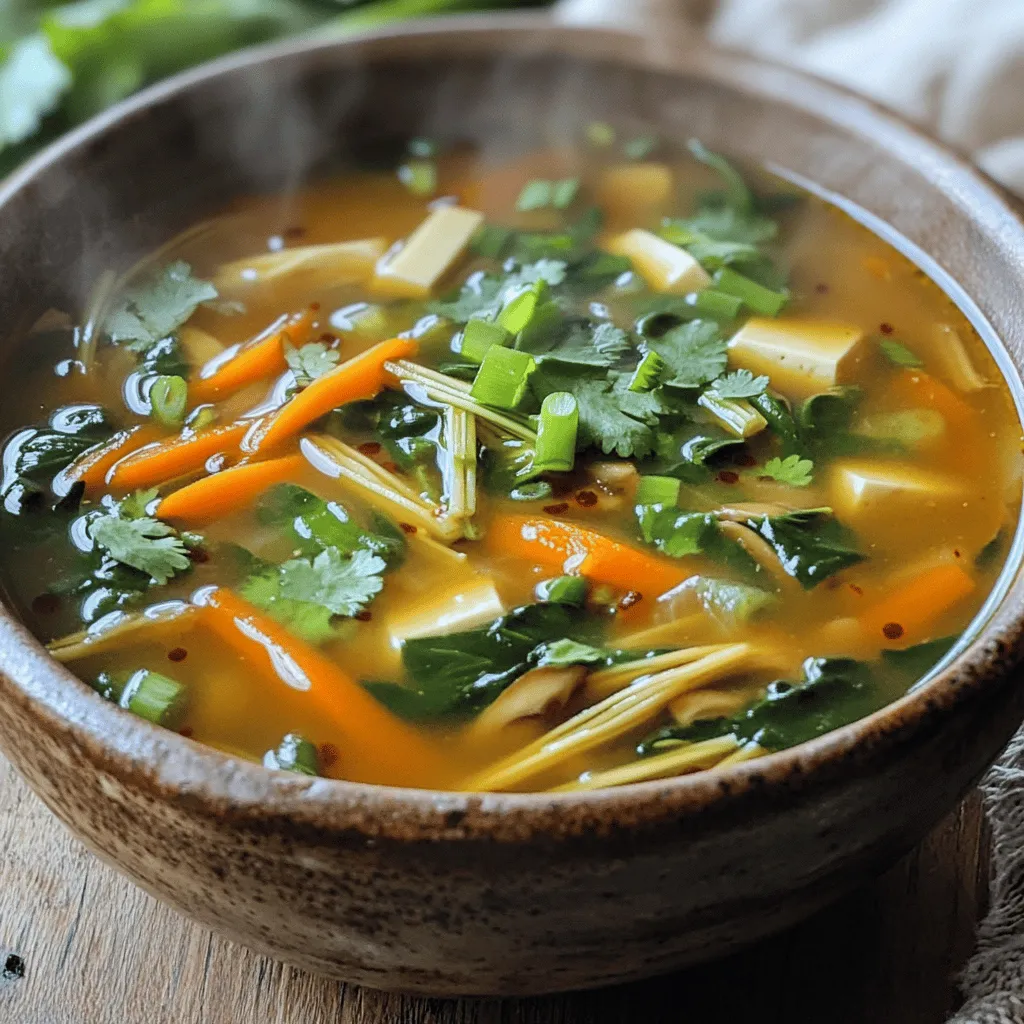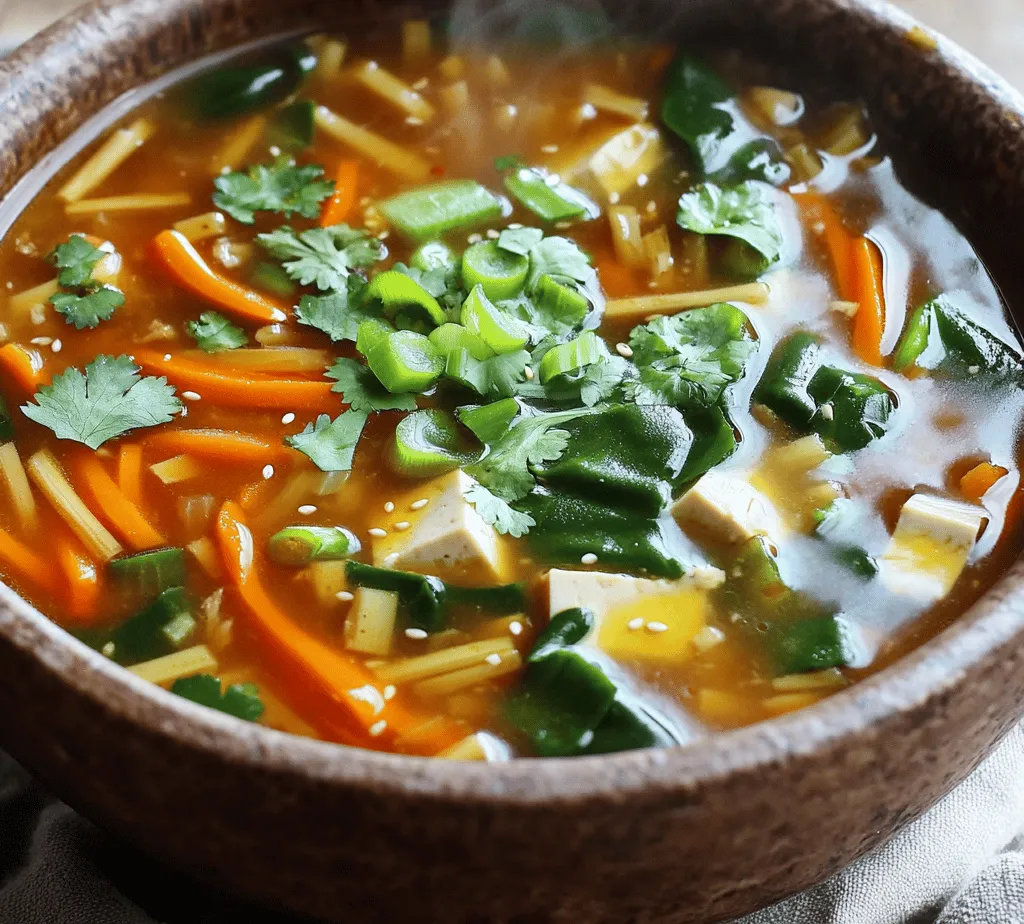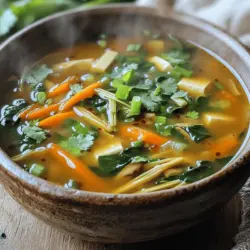Introduction to Spicy Tangy Delight: Easy Hot and Sour Soup
Hot and sour soup is a cherished dish in many Asian cuisines, particularly in Chinese cooking, renowned for its bold flavors and comforting warmth. This beloved soup is a delightful fusion of spicy and tangy elements that awaken the taste buds, making it a favorite for those seeking a hearty and invigorating meal. Traditionally served as an appetizer or a main dish, hot and sour soup offers a perfect balance of flavors that can be both satisfying and rejuvenating, especially during colder months or when you’re feeling under the weather.

One of the most appealing aspects of making hot and sour soup at home is the nutritional benefits it brings. Homemade soup allows you to control the ingredients, ensuring they are fresh, wholesome, and tailored to your dietary preferences. This not only enhances the flavor of the soup but also contributes to a healthier meal, free from preservatives and additives commonly found in store-bought alternatives. Additionally, the joy of cooking and the comforting aroma that fills your kitchen as you prepare the soup can elevate the entire experience, making it a delightful activity for individuals and families alike.
In this article, we will guide you through a quick and easy version of hot and sour soup, perfect for busy weeknights or when you want to impress guests with minimal effort. This recipe can be easily tailored to your taste preferences; whether you like it spicier or more tangy, you can adjust the ingredients accordingly. So let’s dive into this flavorful journey and discover how to create your very own spicy tangy delight.
Understanding the Ingredients
To create a delicious hot and sour soup, it’s essential to use fresh ingredients that enhance both flavor and nutritional value. Fresh produce not only improves the taste but also ensures that you’re getting the maximum health benefits from the soup. Let’s break down the key ingredients that contribute to the vibrant flavors and textures of this dish.
Broth
The base of any great soup is its broth. In the case of hot and sour soup, you have the option of using either vegetable broth or chicken broth. Vegetable broth provides a lighter flavor profile and is suitable for those following a vegetarian or vegan diet. On the other hand, chicken broth adds a rich, savory depth that enhances the overall flavor of the soup. When choosing your broth, consider your dietary preferences and the flavor intensity you wish to achieve.
Tofu
Tofu is an excellent addition to hot and sour soup, serving as a fantastic plant-based protein source. Not only does it contribute to the dish’s heartiness, but it also absorbs the surrounding flavors, making every bite delicious. Tofu is low in calories and rich in nutrients, providing a great balance to the richer broth and other ingredients.
Mushrooms
Mushrooms, particularly shiitake mushrooms, play a crucial role in enhancing the soup’s flavor profile. Known for their earthy taste and chewy texture, shiitake mushrooms add depth and umami to the dish. Additionally, they are packed with health benefits, including antioxidants and immune-boosting properties, making them a fantastic choice for this comforting soup.
Bamboo Shoots and Carrots
Bamboo shoots and carrots contribute both texture and sweetness to the soup. Bamboo shoots add a unique crunch that contrasts beautifully with the other ingredients, while carrots bring a subtle sweetness that balances the soup’s sour and spicy elements. These vegetables not only enhance the flavor but also boost the nutritional content, providing essential vitamins and minerals.
Spinach
Spinach is a nutritional powerhouse that adds vibrant color and a host of health benefits to the soup. Rich in iron, vitamins A and C, and antioxidants, spinach elevates the soup’s nutritional profile while providing a fresh, slightly earthy taste. Adding spinach towards the end of the cooking process ensures it retains its bright color and tender texture.
Aromatics
Garlic and ginger are essential aromatics that build the foundation of flavor in hot and sour soup. Their pungent notes not only add depth but also contribute to the health benefits of the dish. Garlic is known for its anti-inflammatory and immune-boosting properties, while ginger aids digestion and adds a hint of warmth.
Condiments
Finally, the condiments are what truly define the hot and sour character of the soup. Soy sauce provides a salty depth, while rice vinegar introduces the tangy sourness that balances the flavors. Sesame oil adds a nutty richness, and chili paste brings the heat. The combination of these condiments allows you to create a soup that is perfectly balanced between salty, sour, and spicy, catering to your personal preference.
Preparation Steps for the Perfect Soup
Now that we’ve explored the key ingredients, it’s time to focus on the preparation steps to create the perfect hot and sour soup. Each step is crucial in building the flavors and ensuring that the ingredients are cooked to perfection.
Preparing the Broth
The first step in creating a flavorful hot and sour soup is preparing the broth. If you choose to use store-bought broth, be sure to select a high-quality option that is low in sodium to maintain control over the saltiness of your dish. If you’re feeling adventurous, you can make your own broth by simmering vegetables, herbs, and spices for a few hours to extract maximum flavor. For a quick version, simply heat your chosen broth in a large pot over medium heat until it reaches a gentle simmer. This will serve as the foundation of your soup and will absorb all the flavors of the other ingredients.
Sautéing Aromatics
Once the broth is simmering, it’s time to sauté the aromatics. In a separate pan, add a splash of vegetable oil and heat it over medium heat. Add minced garlic and grated ginger, allowing them to cook for about a minute until they become fragrant. This step is essential, as sautéing the aromatics releases their essential oils, intensifying the overall flavor of the soup. Be careful not to burn them, as this can lead to a bitter taste in your final dish.
Cooking Vegetables
After the aromatics have been sautéed to perfection, it’s time to add the vegetables. Start with the shiitake mushrooms, as they take a bit longer to cook. Sauté them for about three to four minutes until they are tender and slightly browned. Next, add the carrots and bamboo shoots, cooking them for an additional two to three minutes. These vegetables should maintain a slight crunch, as you’ll want them to provide texture in the finished soup. Finally, add spinach just a minute before serving to ensure it wilts without losing its vibrant color.
With these initial steps, you are well on your way to creating a delicious bowl of hot and sour soup. The careful preparation and attention to detail will ensure that every spoonful is packed with flavor and warmth, ready to be enjoyed by you and your loved ones.

Incorporating Tofu and Spinach: Best Practices to Prevent Mushiness and Retain Nutrients
Tofu and spinach are two key ingredients in hot and sour soup that not only enhance its flavor profile but also contribute to its nutritional value. However, it’s essential to incorporate them properly to avoid a mushy texture and to retain their health benefits.
When using tofu, opt for firm or extra-firm varieties. Silken tofu, while delicious in other dishes, tends to break apart easily and can create a less desirable texture in soups. Before adding tofu to your hot and sour soup, cut it into cubes and consider briefly pan-frying them in a little oil. This step helps to create a firmer exterior and enhances the flavor. By frying the tofu first, you give it a chance to develop a lovely golden crust, which adds to the overall texture of the soup.
Spinach, on the other hand, should be added towards the end of the cooking process. This ensures that the leaves retain their vibrant green color, nutritional value, and texture. Overcooking spinach can result in a slimy consistency and loss of nutrients. Just a minute or two in the hot broth is enough to wilt the spinach perfectly, allowing it to integrate beautifully into the soup without losing its integrity.
Balancing Flavors with Condiments: The Art of Seasoning to Achieve the Desired Hot and Sour Profile
The secret to a delicious hot and sour soup lies in the balance of flavors. Achieving the perfect hot and sour profile requires a careful selection of condiments and seasonings. Start with the foundational flavors of soy sauce and rice vinegar. Soy sauce contributes umami depth, while rice vinegar introduces the tangy element that defines the dish.
For heat, you can use white pepper, which is the traditional choice for hot and sour soup. White pepper provides a distinct heat without overwhelming the other flavors, making it the perfect option. If you prefer a spicier kick, consider adding a few drops of chili oil or a dash of Sriracha.
To achieve a well-rounded flavor, taste your soup as it cooks and adjust the seasonings accordingly. Remember that flavors will intensify as the soup simmers, so be cautious with additional salt or vinegar. A good rule of thumb is to start with less and gradually build up, ensuring you achieve that delightful balance of hot, sour, and savory.
Thickening the Soup: The Role of Cornstarch Slurry
Thickening your hot and sour soup is crucial to achieving that signature texture. Cornstarch slurry is a popular thickening agent that allows you to control the soup’s consistency without altering its flavor significantly.
Explanation of Cornstarch Slurry: What It Is and How It Works as a Thickening Agent
A cornstarch slurry is simply a mixture of cornstarch and cold water. When heated, cornstarch molecules absorb water and swell, creating a thickening effect. This method is favored in many Asian cuisines because it thickens sauces and soups quickly and effectively.
Step-by-Step Guide to Creating the Perfect Consistency: Timing and Technique for Adding the Slurry
1. Prepare the Slurry: In a small bowl, mix 1 tablespoon of cornstarch with 2 tablespoons of cold water. Stir until smooth, ensuring there are no lumps.
2. Bring the Soup to a Simmer: Before adding the slurry, make sure your soup is at a gentle simmer. This is essential for activating the cornstarch properly.
3. Add the Slurry: Gradually pour the slurry into the soup while continuously stirring. This prevents clumping and ensures an even distribution.
4. Cook Until Thickened: Allow the soup to simmer for an additional minute or two after adding the slurry. You will notice the soup beginning to thicken. If you prefer a thicker consistency, feel free to add a bit more slurry, but be sure to adjust the proportions accordingly.
Garnishing Your Soup for Presentation and Flavor
Garnishing is an important step that elevates your hot and sour soup, enhancing both its visual appeal and flavor profile. The right garnishes can make your dish look more inviting and add layers of flavor that complement the soup’s hot and sour elements.
Importance of Garnishing: Enhancing Visual Appeal and Flavor
Garnishes not only make your dish look appealing but also provide an opportunity to introduce fresh flavors and textures. A well-garnished soup can entice the senses, making the dining experience more enjoyable.
Suggestions for Garnishes: Green Onions, Cilantro, and Their Complementary Flavors
- Green Onions: Finely chop green onions and sprinkle them on top of your soup just before serving. They add a fresh, crisp element and a mild onion flavor that enhances the overall taste.
- Cilantro: Fresh cilantro offers a burst of herbal freshness that contrasts beautifully with the soup’s heat and tang. Add a sprinkle of chopped cilantro for a bright finish.
- Chili Oil or Sesame Oil: Drizzling a little chili oil or toasted sesame oil on top not only adds a beautiful sheen but also an extra layer of flavor.
These garnishes can be adjusted based on personal preferences, making your hot and sour soup unique every time you prepare it.
Nutritional Benefits of Hot and Sour Soup
Hot and sour soup is not only comforting and delicious, but it also boasts a range of health benefits. Understanding these nutritional aspects can enhance your appreciation for this classic dish.
Overview of Health Benefits: Low-Calorie, High-Nutrient Profile
One of the standout features of hot and sour soup is its low-calorie count. The combination of broth, vegetables, and lean protein sources such as tofu makes it a light yet satisfying meal. Additionally, the variety of ingredients contributes to a high nutrient profile, including essential vitamins and minerals.
Discussion on Vegetarian and Vegan Options: How to Customize the Recipe for Different Dietary Needs
Hot and sour soup can easily be adapted to suit vegetarian and vegan diets. Substituting chicken broth with vegetable broth and using tofu as the protein source makes this dish accessible for those following plant-based lifestyles. Furthermore, you can include a variety of vegetables such as mushrooms, carrots, and bell peppers to enhance the nutritional value and add depth to the flavor.
The Impact of Ingredients on Overall Health: Benefits of Fiber, Protein, and Vitamins from the Various Components
The ingredients in hot and sour soup often include mushrooms, which are rich in antioxidants, and spinach, which provides iron and vitamins A and C. Tofu adds a healthy dose of plant-based protein, making this soup not only filling but also supportive of muscle health and overall wellness.
Cultural Significance of Hot and Sour Soup
Hot and sour soup is not just a dish; it carries a rich cultural history that spans across various Asian countries. Understanding its origins and variations can deepen your appreciation for this beloved recipe.
Historical Context: Origin and Evolution of the Dish in Different Cultures
Hot and sour soup is believed to have originated in China, with roots tracing back to the Tang Dynasty. Over the centuries, it has evolved into various regional interpretations, each with its unique twist. The traditional Chinese version often features ingredients like bamboo shoots, mushrooms, and pork, while other cultures have adapted the recipe to suit local tastes.
Regional Variations: How Hot and Sour Soup Varies Across Asia and Its Cultural Importance
In different parts of Asia, you will find distinct versions of hot and sour soup. For example, in Thailand, the soup may incorporate coconut milk, offering a creamier texture and a slightly sweeter flavor. Meanwhile, Vietnamese variations might include a different mix of herbs and spices, emphasizing freshness and brightness.
The cultural significance of hot and sour soup extends beyond its culinary appeal; it often represents familial bonds and communal dining experiences. Sharing a bowl of hot soup is a comforting ritual that brings people together.
Conclusion: Enjoying Your Spicy Tangy Delight
Making homemade hot and sour soup is a rewarding experience that combines comfort, flavor, and health benefits. The process of creating this dish allows you to explore various ingredients and customize it to your taste preferences. From the initial simmering of the broth to the final garnishing touches, each step contributes to a satisfying bowl of soup that warms both the body and soul.
As you experiment with different ingredients and flavors, don’t hesitate to make this recipe your own. Whether you prefer a spicier kick or a more subdued flavor, the flexibility of hot and sour soup allows for endless possibilities.
Ultimately, taking the time to prepare this dish from scratch not only nourishes your body but also fosters a sense of accomplishment and joy. So, gather your ingredients, embrace the process, and enjoy the spicy tangy delight that is hot and sour soup.







Leave a Reply